David Suzuki's Blog, page 66
May 27, 2015
Canada's booming clean technology industry will bust without political support
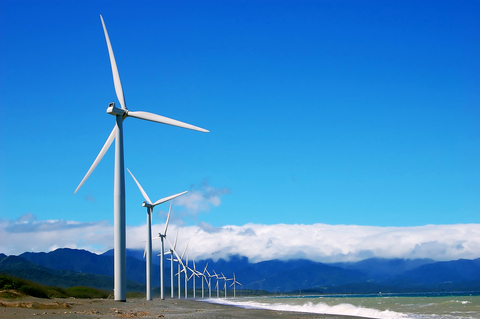
(Credit: Shutterstock)
Canada's opportunity to become a global leader in innovation and clean technology may be slipping away, according to a new report released today by Analytica Advisors. The fourth installment of their annual report on the state of this increasingly important industry says that Canada has lost 41 per cent of its global market share since 2008 -- the third largest loss of any country measured.
It's not too late to turn this trend. Canada's clean technology companies continue to demonstrate that rapid economic growth is the rule, not the exception. The industry as a whole grew four times faster than the overall Canadian economy last year and now employs 50,000 people in more than 800 firms. Clean technology employment in Canada now exceeds forestry, pharmaceuticals, medical devices and aerospace manufacturing. One-fifth of these employees are under the age of 30, showing that clean technology is the industry of the future. If the sector can maintain its eight per cent growth rate, it will employ 100,000 Canadians by 2022.
Instead of diversifying Canada's economy, over the past decade the federal government has focused on boosting the fossil fuel sector. The risks of a one-resource-based economic plan are showing up now in the wake of falling oil prices.
Though Canada's clean tech sector is growing quickly, it's underperforming and losing ground to other countries that have made innovation a key economic priority for the 21st century.
Today, Canada's clean tech market represents 1.3 per cent of that industry's global market, while Canada represents 2.5 percent of the total global economy. Achieving just our market potential would contribute $50 billion to the Canadian economy (up from nearly $12 billion today).
Canada's clean technology companies occupy ten distinct sectors, from power generation to transportation, water, wastewater and agriculture. That means the industry is more resilient to changing market conditions than fossil fuels -- which get far more political support. The new report's number one recommendation is that government leaders make a stronger effort to support the clean technology industry through provincial- and federal -level energy policies, as well as by increasing access to debt for companies involved. The report also says it's time to end the jobs vs. environment debate that has distracted Canada while other countries that have invested in clean tech reap economic rewards.
Change is already underway in Canada. In Ontario, the provincial government is investing in public transportation while increasing renewable energy capacity. Even Alberta, the home of the oil and gas sector and Canada's greatest carbon emitter, uses revenue from its high-emitters carbon tax to invest in clean technology.
Let's step up our national commitment and recognition of this rapidly growing industry before it's too late. In the past, Canada's early leadership in biotechnology and cable and satellite industries slipped away because of reluctant political support. It's foolish to let that happen again. Canadian policy needs to embrace the future in the same way its entrepreneurs and citizens already have. Otherwise, we'll be left in the dust.
Hey! Want more DSF? Join David Suzuki on Facebook
Five reasons to have a sole-ful meal

Fried sole is a classic dish that never gets old. (Credit: lhongchou via flickr)
By Public Engagement Specialist Kyle Empringham
If you're looking for a tasty and affordable seafood option for your next meal, consider sole.
Sole is related to a whole suite of flatfish, often marketed as flounder, halibut, plaice, sanddab and turbot. Pacific flatfish, like their Atlantic counterparts, are known as "hirame" when prepared for sushi.
Looking to make some "sole" food at home? Here are five reasons why sole is a great choice:
1. Sole is versatile.
If you're looking to add some protein to your next meal, sole's a good option. It tastes great as a simple addition to tacos. Or you can add breading to bind it together and turn it into a burger. Taste-wise, it's comparable to tilapia or basa.
2. Sole is quick to prepare.
On average, a sole fillet takes only 10 minutes to cook! Be careful not to overcook it -- that'll make it dry and flaky, so be sure to check it regularly.
3. Sole is affordable.
Lots of seafood options are thought of as high-priced and not accessible to the average consumer. But sole is often less expensive than other fish like halibut and salmon. Check your local store to see how much sole is where you live.
4. Sole stocks are healthy.
There's a lot of sole in the ocean! Because this fish is well-managed, there's little concern about depleting populations.
5. Sole is recommended by SeaChoice.
All Pacific sole is ranked as a green "Best Choice" or yellow "Good Alternative" by SeaChoice. The fishery is well-managed with few concerns about any unwanted catch (or "bycatch"). Most sole are caught using bottom trawls, but this is primarily carried out over seafloors that recover quickly from the effects of trawling.
If you're an iPhone user, download the new SeaChoice app from the app store. You'll be able to see different rankings of sole based on where they're from and how they're caught. Once you ask your fish monger about sole, head to the app to see which option is best for the oceans.
Hey! Want more DSF? Join David Suzuki on Facebook
May 26, 2015
How not to squelch a kid's curiosity about nature
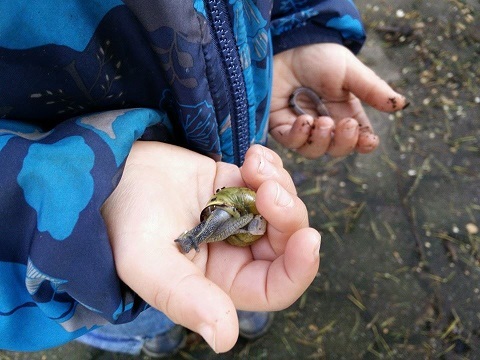
To cultivate nature connectedness, fuel curiosity and keep plants and critters alive, we made rules.
Most children are curious explorers, so you don't need to do much to cultivate their nature connectedness -- just take them outside! The challenge is more about how to get out of their way while keeping them AND the plants and critters safe.
Ick. Ew. Gross.
These are a few words adults say about nature -- in front of kids. I don't think we even realize it.
Did I love finding a snail on my kitchen ceiling? Or an entire nest of baby spiders, on a stick, in my living room? Not exactly.
To cultivate nature connectedness, fuel my son's curiosity and keep plants and critters alive, we have rules:
No snails in the house.
Worms can't do yoga.
No slugs in the hand (the sticky trail is impossible to get off).
Toilet paper can help relocate spiders.
Bees are fun to watch, not touch.
Ant hills are best observed from a distance.
Caterpillars need to be released to morph into butterflies or moths.
Ladybugs are heart-breakers. They will land on you and then fly away without a moment's notice.
Wasps and bees need space because they can sting.
Leave some snails behind to work in the garden and for other kids to find.
Don't get me wrong, I will let him swat mosquitoes!
Tools you may find useful:
Bug bungalow or a mason jar with air holes (much better than pockets)
Butterfly net
Magnifying glass
Dip net (to explore streams and ponds)
Tips from our 30×30 Nature Challenge (to inspire your outdoor explorations any time of year!)
How have you successfully taught the kids in your life about touching, holding and exploring nature safely?
Sincerely,
Lindsay Coulter, a fellow Queen of Green
Hey! Want more DSF? Join David Suzuki on Facebook

May 25, 2015
Milkweed backgrounder
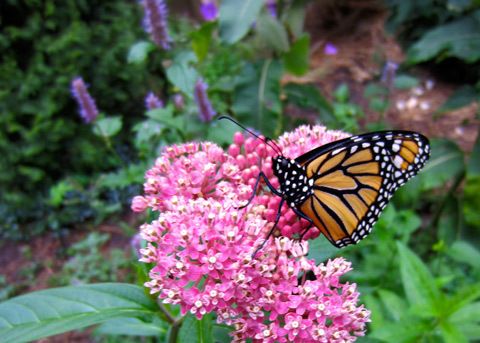
(Credit: Rick and Brenda Beerhorst via Flickr)
There are three varieties of milkweed that grow in Ontario: Common Milkweed, Swamp Milkweed and Butterfly-Weed. Here are some tips on how to grow milkweed, as well as information about the three types.
Growing milkweed
Soil types
If you have a choice, light soils are better than those with heavy clay. Well-drained soils are generally best but Swamp milkweed do well in saturated conditions.
Where to plant
Most milkweed species evolved in open areas where they were exposed to full sunlight and they will do best if they are planted in the sunniest areas of your gardens.
Planting
Your seedlings should be planted at least six inches apart. Newly transplanted plants should be watered frequently. Add mulch around the seedlings soon after planting. The mulch holds in the moisture and minimizes the growth of competing weeds. To prevent spreading you may wish to add a border below the soil to separate milkweed from other parts of your garden.
Care and maintenance
The seedlings should be fertilized 2-3 times during the growing season if using water-soluble fertilizer or once a season if you utilize a granulated time-release formulation.
Preventing spreading
Common milkweed spreads both through seeds and rhizomes - underground lateral roots. To prevent spreading, you may wish to both add a below soil border and remove the seed pods before they open. Similar to dandelions, milkweed will spread to distant corners of your yard and beyond, thanks to the silky appendages that allow the seeds to waft on the slightest breeze.
Harvest and storage of milkweed seeds
The timing of the collection of milkweed pods or seeds is critical. If you squeeze the pods and they don't open easily, they usually do not contain mature brown seeds. Seeds well into the process of browning and hardening will germinate when planted the next season. Pale or white seeds should be not collected. Freshly collected pods should be dried in an open area with good air circulation. Once the pods are thoroughly dry, the seeds can be separated from the coma, or silk-like ballooning material, by hand. Store dried seeds in a cool, dry place protected from mice and insects - a plastic bag or other container in the refrigerator works well.
Milkweed types
Common milkweed (_Asclepias syriaca_)
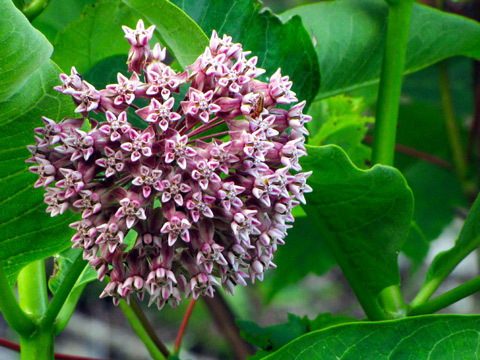
Common milkweed (Photo credit: Flickr user BlueRidgeKitties)
Characteristics:
• Dense spherical umbels (flowers) at tip of stem and axils of upper leaves
• Flowers greenish to purple or white
• Pods, green, fleshy, covered with soft warty protuberences
Habitat: Pastures, meadows, roadsides
Range in Ontario: Common in southern and northern Ontario.
Swamp milkweed (_Asclepias incamata_)
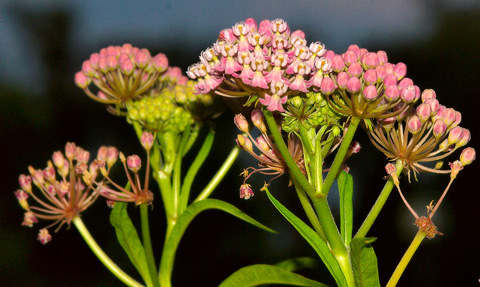
Swamp milkweed (Photo credit: Danny Barron via Flickr)
Characteristics:
• Narrow-lanced shaped leaves, smooth
• Flowers dull pink to rose-purple
• Slender pods
• Smoothed stem
Habitat: swamps and wet meadows, ditches, edges of streams, shorelines
Range in Ontario: Throughout Great Lakes region of Ontario
Butterfly-weed (_Asclepias tuberose_)

Butterfly-weed (Photo credit: Aaron Carlson via Flickr)
Characteristics:
• Distinct showy orange flower (sometimes yellow)
• Alternate leaves
• Leaves lanced shaped
• Juice not milky
• Narrow pods
Habitat: Sandy fields especially tall grass prairie and savanna communities.
Range in Ontario: Mostly Carolinian regions especially in sandy meadows
Hey! Want more DSF? Join David Suzuki on Facebook
May 21, 2015
Good things are growing in Ontario's greenbelt
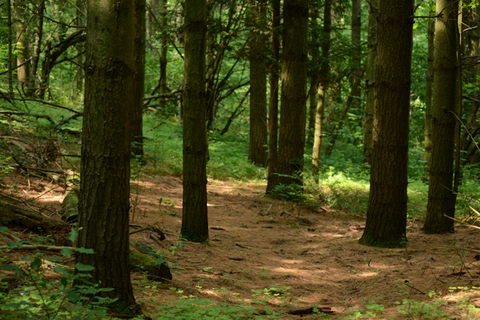
(Credit: Ontario Nature via Flickr)
More than half the planet's people now live in urban areas. The need to supply food, shelter, fresh water and energy to billions of urban residents is resulting in loss of farmland, forests, wetlands and other ecosystems, as well as the critical ecological services they support, like providing food, clean air and drinking water.
Almost half of Canada's urban base is on land that only a few generations ago was being farmed. According to Statistics Canada, nearly four million hectares of farmland -- an area larger than Vancouver Island -- were lost from 1971 to 2011, mostly due to urbanization.
A growing number of jurisdictions have responded by enacting strong land-use policies to protect farmland and green space through sound urban planning. In the 1970s, Oregon's government imposed strict urban-growth boundaries around a number of cities, including Portland. As a result, growth in the city was confined to existing built-up areas, thereby preventing development from spilling out to farmers' fields. Many developers and businesspeople fought the plan, arguing it would hurt the economy, but Portland is now recognized as one of the most livable cities on the continent. It has facilitated densification, improved walkability and decreased the cost of energy and transportation for homes and businesses.
In Canada, Ontario has enacted the Growth Plan for the Greater Golden Horseshoe to encourage towns and cities to grow upwards through densification rather than outwards through car-dependent urban sprawl. Ontario has also established a two-million-acre greenbelt of protected farmland and green space, which wraps around the Greater Golden Horseshoe's major towns and cities, including Toronto, Hamilton, Markham and Burlington.
Ontario's government is reviewing the Growth Plan and the Greenbelt Plan, along with two other adjoining land-use plans, which work together to manage growth, protect the natural environment and support economic development. This coordinated review process offers an opportunity to examine modern land-use planning and assess whether Ontario's approach to managing growth should be applied to other towns and cities facing similar urban pressures.
A major outcome of the plans has been their success in protecting farmland from development and revitalizing Southern Ontario's agricultural industry. The greenbelt alone, comprising just over 20 per cent of the region, generates more than $9 billion in annual revenue to local economies, producing a bounty of fruits and vegetables, beef, pork, dairy, honey and award-winning wines.
David Suzuki Foundation research shows the greenbelt's farmland and green spaces also provide an estimated $2.6 billion annually in non-market benefits, such as water filtration by watersheds. This saves local municipalities hundreds of millions of dollars they would otherwise have to spend on water infrastructure and treatment facilities.
The Growth Plan and greenbelt also encourage smarter urban growth in the region through more efficient use of available land -- which in turn reduces the amount and cost of infrastructure and supports public transit. A recent report by urban planning group the Neptis Foundation found urban expansion has slowed since plans were implemented. From 1991 to 2001, the footprint of Toronto and surrounding suburbs grew by 26 per cent to accommodate about 1.1 million new residents. Between 2001 and 2011 it expanded by just 10 per cent to accommodate roughly the same number of newcomers.
Although the Greenbelt Plan is curbing sprawl and protecting farmland and green space, it's far from secure -- and the remaining 80 per cent of the region's farmland and natural systems remain unprotected. Proposed highways, pipelines, hydro corridors and sprawling, car-dependent subdivisions could fragment natural and agricultural systems and enable leapfrog development outside the greenbelt's borders -- with extensive land speculation in expectation of the type of sprawl these plans were intended to prevent. Environmentalists have joined farmers and local food advocates to urge Ontario's government to strengthen regulatory protection for the greenbelt and to expand it.
Canada's towns and cities are at a crossroads. One path leads to continued low-density, sprawling urban expansion, with endless pavement, long commutes and traffic jams, and the high social and ecological costs of wasteful forms of urban design. The other path ends sprawl by creating compact, higher-density communities with mid-rise housing and access to public transit, bike paths and walking trails, surrounded by precious farmland and green spaces like Ontario's renowned greenbelt. What kind of cities do you want?
To support the Ontario Greenbelt, go to http://action2.davidsuzuki.org/greenbelt.
YES - I want to help protect the Greenbelt
Hey! Want more DSF? Join David Suzuki on Facebook

May 20, 2015
Sea lice: An old problem that won't go away
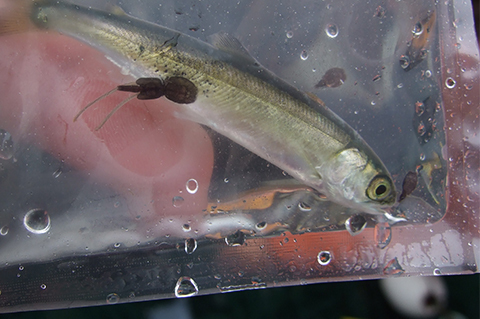
(Credit: Watershed Watch via Flickr)
By John Werring, senior science and policy adviser
Some things -- like sea lice -- just won't go away. Sea lice are a naturally occurring parasite of ocean fish and need hosts to survive. A sea louse's preferred host is an adult salmon, and the more fish there are in the water the greater the number of lice. Since wild salmon migrate, sea lice numbers in waters near the shore are typically low when the salmon are at sea and spike when the salmon return in the fall. When juvenile salmon migrate out of their home streams in the spring and enter the salt water, sea lice numbers are usually low (because they have no hosts to feed on during the winter), so encounters between fish and lice are fairly rare. There have been very few documented events where natural sea lice numbers are so high that they actually become a problem for wild fish.
Fish farms have altered this natural balance. Millions of farmed salmon are held captive in pens for up to two years, providing sea lice with a year-round supply of hosts and allowing the lice to breed in enormous numbers, including when wild salmon are absent. When sea lice reproduce, their microscopic offspring are carried away from farms on ocean currents, leaving more in the surrounding environment. Thus, when juvenile fish exit their home rivers in spring and enter the sea in areas where there are fish farms, they can encounter far higher numbers of lice than evolution has prepared them for. This has led to entire stocks of wild salmon lost to sea lice.
The David Suzuki Foundation, along with the Coastal Alliance for Aquaculture Reform, has worked during the past decade with government and the aquaculture industry to come up with strategies to protect wild B.C. salmon from parasitic sea lice. We convinced them that reducing farms along major salmon migration routes was an effective strategy; we convinced them to monitor and publicly report weekly sea lice numbers on farms during the salmon out-migration period; and we convinced them to treat farms with high sea lice infestations well in advance of the wild salmon migration.
We could monitor how farms were doing ourselves because the data were timely and publicly available. This has changed. New research by Alexandra Morton suggests that this year's wild salmon in the Broughton Archipelago are heavily infested with sea lice. This means one of two things: either effective sea lice management strategies are not being followed, or they are and the chemicals used to treat fish for sea lice, such as SLICE, or emamectin benzoate, are not as effective as they once were. Maybe the lice have developed resistance to the chemical treatments.
To know for sure requires data from the Department of Fisheries and Oceans Canada. Since it took over management of the aquaculture industry (fish farms) in 2010, DFO has collected quarterly data on the prevalence of sea lice on farmed salmon as well as information about the amount of chemicals being used to treat for lice. By the time DFO reviews, formats and translates this data into publically available reports they are hopelessly out of date, sometimes by as much as nine months. In practice, that means up-to-date data about the source of a serious environmental problem are not available.
Meanwhile, DFO scientists have determined that "environmental conditions have been ideal this past season for high challenge levels of sea lice in the Broughton: the warm, dry winter may have contributed to faster sea lice development ... compared with a normal year." (From personal email correspondence from Fisheries and Oceans Canada.)
They argue this is why wild fish are showing lice infestations, yet they won't let us see farmed fish data even though farmed fish are hosts for sea lice too.
There's something fishy going on and wild salmon are the big losers.
Help us protect the coast: become an Ocean Keeper »
Hey! Want more DSF? Join David Suzuki on Facebook

May 15, 2015
Canada must do better than federal target to fight climate change
Climate change is the most serious issue threatening our communities and security. It is critically important for developed nations like Canada to take a leading role in cutting emissions and finding solutions.
The target released today by the federal government falls short of what the David Suzuki Foundation thinks is necessary and feasible for Canada. Our research has shown that if the existing best-in-country practices at the provincial level were adopted country-wide, Canada would already be on track to meet its 2020 emission target. Instead, as the Office of the Auditor General of Canada has reported, the lack of a unifying approach by the federal government is one of the main reasons Canada is unlikely to meet its own 2020 emission target (let alone for goals for 2030).
Parts of our country are already doing great things. There is no reason we can't be as ambitious as a nation. Canada can and must do better to shrink carbon pollution and prioritize clean energy.
Ian Bruce, science and policy manager, David Suzuki Foundation
Hey! Want more DSF? Join David Suzuki on Facebook

May 14, 2015
Signs of change are sweeping the nation
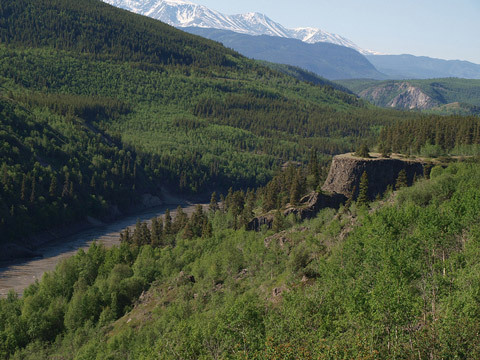
In my home province, after a long struggle by elders and families of the Tahltan Klabona Keepers, the B.C. government bought 61 coal licences from Fortune Minerals and Posco Canada in the Klappan and Sacred Headwaters, putting a halt to controversial development in an ecologically and culturally significant area that is home to the Tahltan people and forms the headwaters of the Skeena, Stikine and Nass rivers. (Credit: Bruce McKay via Flickr)
Recent events in Canada have shown not only that change is possible, but that people won't stand for having corporate interests put before their own.
When plummeting oil prices late last year threw Alberta into financial crisis, people rightly asked, "Where's the money?" They could see that an oil producer like Norway was able to weather the price drop thanks to forward planning, higher costs to industry to exploit resources and an oil fund worth close to $1 trillion! Leading up to the election, the government that ran Alberta for 44 years refused to consider raising industry taxes or reviewing royalty rates, instead offering a budget with new taxes, fees and levies for citizens, along with service cuts.
The people of Alberta then did what was once thought impossible: they gave the NDP a strong majority. Almost half the NDP members elected were women, giving Alberta the highest percentage of women ever in a Canadian provincial or federal government.
On the other side of the country, voters in Prince Edward Island followed B.C. provincially and Canada federally and elected their first Green Party member, as well as Canada's second openly gay premier. Remember, homosexuality was illegal in Canada until 1969!
In my home province, after a long struggle by elders and families of the Tahltan Klabona Keepers, the B.C. government bought 61 coal licences from Fortune Minerals and Posco Canada in the Klappan and Sacred Headwaters, putting a halt to controversial development in an ecologically and culturally significant area that is home to the Tahltan people and forms the headwaters of the Skeena, Stikine and Nass rivers. The Tahltan and the province have agreed to work on a long-term management plan for the area.
On the same night as Alberta's election, people of the Lax Kw'alaams band of the Tsimshian First Nation met to consider an offer by Malaysian state-owned energy company Petronas of $1 billion over 40 years to build a liquefied natural gas export terminal on Lelu Island near Prince Rupert, at the other end of the Skeena River, an estuary that provides crucial habitat for salmon and other life. The 181 people attending unanimously opposed the offer. Two nights later in Prince Rupert, band members also stood unanimously against the proposal.
A final vote was scheduled after this column's deadline, but the message is clear: integrity, the environment and human health are more important than money. Gerald Amos, a Haisla First Nation member and community relations director for the Headwaters Initiative, said the federal Prince Rupert Port Authority's decision to locate the facility on Lelu Island also demonstrated a failure to properly consult with First Nations. "By the time they get around to consulting with us, the boat's already built and they just want to know what colour to paint it," he said.
On a broader scale, change is occurring around the serious threat of climate change. Even well-known deniers, including U.S. oil billionaire Charles Koch, now admit climate change is real and caused in part by CO2 emissions. But they argue it isn't and won't be dangerous, so we shouldn't worry. Most people are smart enough to see through their constantly changing, anti-science, pro-fossil-fuel propaganda, though, and are demanding government and industry action.
We're also seeing significant changes in the corporate sector. The movement to divest from fossil fuels is growing quickly, and businesses are increasingly integrating positive environmental performance into their operations. Funds that have divested from fossil fuels have outperformed those that haven't, a trend expected to continue.
We can't expect miracles from Alberta's new government, which has its work cut out. After all, it would be difficult to govern Alberta from an anti-oil position, and the fossil fuel industry is known for working to get its way. Although NDP leader Rachel Notley has spoken against the Northern Gateway pipeline proposal, she isn't opposed to all pipeline and oilsands development, and she's called for refinery construction in Alberta. But she's promised to phase out coal-fired power, increase transit investment, implement energy efficiency and renewable energy strategies, and bring in stronger environmental standards, monitoring and enforcement.
I've often said things are impossible only until they aren't anymore. The past few weeks show how people have the power to bring about change.
Hey! Want more DSF? Join David Suzuki on Facebook

May 13, 2015
David Suzuki to visit B.C. communities
Celebrating Coastal Connections tour begins in June
David Suzuki will visit 12 B.C. communities, from Smithers in the north to Nanaimo in the south, between June 1 and 13 this year.
The Celebrating Coastal Connections events will draw on the long history of work, activism and friendship that David Suzuki and the David Suzuki Foundation have with B.C.'s coastal communities.
"These communities are close to my heart, and I'm looking forward to honouring our shared past and building a future together that is both ecologically sustainable and economically vibrant," Suzuki said.
Recent events such as shellfish die-offs on Vancouver Island, low snow packs, pine beetle devastation and altered growing seasons highlight the need for creative and quick responses from coastal communities to climate change and other environmental challenges.
The tour will feature a film about climate change in B.C. by Ian Mauro, an award-winning community-based researcher and filmmaker. Mauro's documentaries include Qapirangajuq: Inuit Knowledge and Climate Change and Climate Change in Atlantic Canada. The David Suzuki Foundation has supported Mauro in documenting climate change's impacts on the West Coast.
"We're hoping to celebrate, motivate and connect coastal communities, First Nations and partners around our shared respect and admiration for the coastal waters that make British Columbia such an amazing place to live," said David Suzuki Foundation Western Canada director Jay Ritchlin. "We want to hear about the challenges facing our coastal communities, successes in overcoming those challenges and visions for a healthy future."
Tour stops will include Nanaimo, Port Alberni, Comox, Campbell River, Alert Bay, Port Hardy, Bella Bella, Smithers, Kitimat, Prince Rupert, Masset and Skidegate. Schools will participate through art projects about students' connections to their coastal homes.
Communities are asked to check the schedule for David's appearances and register for an event here.
Invitation for tour volunteers (Ocean Keepers Ambassador position).
To request a media interview while David Suzuki is on tour, please contact:
Panos Grames
604-816-7118; panos@davidsuzuki.org
Hey! Want more DSF? Join David Suzuki on Facebook

May 7, 2015
Digging science: Citizens amplify knowledge about the natural world
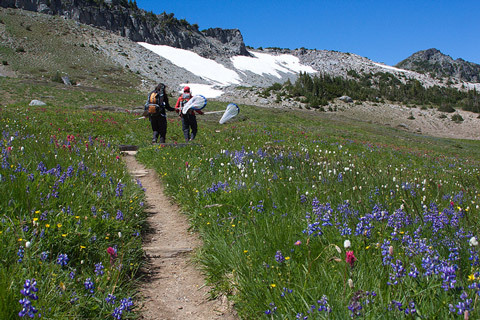
(Credit: Mount Rainier National Park via Flickr)
One of this year's most popular Sundance Film Festival entries, Tangerine, was shot with an iPhone 5S and edited with an $8 app called Filmic Pro. New technology has also made music easier to produce and distribute, inspiring independent musicians. Science, too, is now in the hands of citizens around the world. From the ocean depths to the outer reaches of distant galaxies, and from projects run out of home garages to research platforms with over a million volunteer contributors, science has never been more accessible to the average person. Citizen science can link people to an established project or encourage those working on their own.
We're on the cusp of a major revolution in the way we approach environmental science. In February, a water sample showed that the first trace amounts of ocean-borne radioactive contamination from the 2011 Fukushima nuclear disaster reached North American shores. The sample wasn't taken from an oceanographic vessel. It was collected in a 20-litre sample bottle from the public dock in Ucluelet, B.C., by a class of Grade 5 and 6 girls participating in a Woods Hole Oceanographic Institution project that connects concerned citizens from North American communities around the Pacific shores. A decade ago, this type of organizing and sample-taking by engaged citizens would have been inconceivable.
Along with valuable scientific information, citizen scientists also provide significant economic support to science. A paper in the journal Biological Conservation estimates that citizen science has contributed billions of dollars of in-kind funding and even exceeded most government-funded studies over a larger area and longer time period.
Glen Dennison, an electronic technologist during the week and recreational diver and deep-sea researcher on his time off, offers an example of this new way to conduct science. He's been in B.C.'s Howe Sound mapping sponge reefs nearly every weekend over the past five years, using his own underwater sonar mapping equipment and homemade sewer pipe cameras (cameras housed in a pipe that can be dropped up to 300 metres to the seafloor). Were the government to undertake this work, it could cost thousands of dollars a day for vessel time and salaries. With assistance from his daughter and a grad student, Dennison has contributed more than $100,000 of his own time and resources to this project. Government researchers have used his maps to better manage sensitive marine ecosystems.
Citizen science is growing in leaps and bounds. Recently, NatureWatch revamped its website and its popular WormWatch, FrogWatch, PlantWatch and IceWatch programs. For the first time in NatureWatch's 15-year history, people can use phones or tablets to record, submit and view data. Environmental monitoring is happening as people walk to work, go on vacation or even play golf. You never know when you'll find a frog in a water hazard!
NatureWatch's website walks people new to science through everything they need to know. Like the girls in Ucluelet, you could even make a scientific discovery. Amateur bee observers participating in the American BeeSpotter program identified bee species thought to have disappeared in some areas. You don't even need to live in the area you're observing to record scientific data. A Minnesota-based volunteer recorded, for the first time ever, a major migration of deep-sea crabs on Canada's West Coast by reviewing underwater video footage online as part of a program run by Ocean Networks Canada in Victoria.
Just as people who learn first aid are not substitutes for paramedics and doctors, citizen science should never be a justification for cutting government science spending. Governments in countries like the U.S. are funding citizen science programs to amplify the effectiveness of government science programs. The U.S. National Oceanographic and Atmospheric Administration facilitates 65 citizen science programs alone. The U.S. Environmental Protection Agency runs dozens of programs in areas ranging from water quality to air pollution monitoring.
Many citizen science programs are based on the simple notion that more eyes lead to better findings. Whether taking pictures of frogs, recording the state of the ice on a local pond or viewing underwater footage taken from the sea floor, citizen science is making a great contribution to Canada's scientific knowledge. We're just beginning to realize the full potential of using technology to connect curiosity and concern for the planet with meaningful scientific pursuits.
Hey! Want more DSF? Join David Suzuki on Facebook

David Suzuki's Blog
- David Suzuki's profile
- 247 followers



